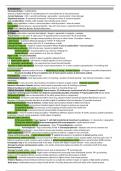College aantekeningen
Advanced Neuropsychology | Full Exam Notes | Utrecht University | A+ Study Guide
- Instelling
- Universiteit Utrecht (UU)
University: Utrecht University Course: Advanced Neuropsychology This document provides comprehensive full exam notes covering all key topics in advanced neuropsychology, including: - Perception and visual processing, including agnosia, prosopagnosia, and visual pathways - Attention and execut...
[Meer zien]




